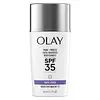What's inside
What's inside
 Key Ingredients
Key Ingredients

 Benefits
Benefits

 Concerns
Concerns

 Ingredients Side-by-side
Ingredients Side-by-side

Water
Skin ConditioningTapioca Starch
Dimethicone
EmollientNiacinamide
Smoothing3-O-Ethyl Ascorbic Acid
Skin ConditioningTocopheryl Acetate
AntioxidantCaprylyl Glycol
EmollientDimethiconol
EmollientCetearyl Glucoside
EmulsifyingCetearyl Alcohol
EmollientStearic Acid
CleansingPalmitic Acid
EmollientDisodium EDTA
Sodium Polyacrylate Starch
AbsorbentPEG-100 Stearate
Polymethylsilsesquioxane
1,2-Hexanediol
Skin ConditioningPhenoxyethanol
PreservativeIodopropynyl Butylcarbamate
PreservativeParfum
MaskingAscorbic Acid
AntioxidantTocopherol
AntioxidantOctocrylene 3%
UV AbsorberWater, Tapioca Starch, Dimethicone, Niacinamide, 3-O-Ethyl Ascorbic Acid, Tocopheryl Acetate, Caprylyl Glycol, Dimethiconol, Cetearyl Glucoside, Cetearyl Alcohol, Stearic Acid, Palmitic Acid, Disodium EDTA, Sodium Polyacrylate Starch, PEG-100 Stearate, Polymethylsilsesquioxane, 1,2-Hexanediol, Phenoxyethanol, Iodopropynyl Butylcarbamate, Parfum, Ascorbic Acid, Tocopherol, Octocrylene 3%
Polyamide-8
EmollientC12-15 Alkyl Benzoate
AntimicrobialCoco-Caprylate/Caprate
EmollientIsopropyl Isostearate
EmollientButyloctyl Salicylate
Skin ConditioningPolyamide-3
Vp/Eicosene Copolymer
Tetrahexyldecyl Ascorbate
AntioxidantTocopheryl Acetate
AntioxidantTocopherol
AntioxidantHylocereus Undatus Fruit Extract
Skin ConditioningRubus Chamaemorus Seed Oil
Skin ConditioningGlycine Soja Oil
EmollientCaprylyl Glycol
EmollientDiethylhexyl Syringylidenemalonate
Skin ProtectingPolyglyceryl-3 Diisostearate
EmulsifyingOryza Sativa Germ Extract
EmollientOryza Sativa
Octocrylene 3%
UV AbsorberPolyamide-8, C12-15 Alkyl Benzoate, Coco-Caprylate/Caprate, Isopropyl Isostearate, Butyloctyl Salicylate, Polyamide-3, Vp/Eicosene Copolymer, Tetrahexyldecyl Ascorbate, Tocopheryl Acetate, Tocopherol, Hylocereus Undatus Fruit Extract, Rubus Chamaemorus Seed Oil, Glycine Soja Oil, Caprylyl Glycol, Diethylhexyl Syringylidenemalonate, Polyglyceryl-3 Diisostearate, Oryza Sativa Germ Extract, Oryza Sativa, Octocrylene 3%
Ingredients Explained
These ingredients are found in both products.
Ingredients higher up in an ingredient list are typically present in a larger amount.
Caprylyl Glycol is a humectant and emollient, meaning it attracts and preserves moisture.
It is a common ingredient in many products, especially those designed to hydrate skin. The primary benefits are retaining moisture, skin softening, and promoting a healthy skin barrier.
Though Caprylyl Glycol is an alcohol derived from fatty acids, it is not the kind that can dry out skin.
This ingredient is also used as a preservative to extend the life of products. It has slight antimicrobial properties.
Learn more about Caprylyl GlycolOctocrylene protects skin from sun damage. It absorbs UV-B with peak absorption of 304 nm. It is a common sunscreen ingredient and often paired with avobenzone, a UVA filter. This is because octocrylene stabilizes other sunscreen ingredients by protecting them from degradation when exposed to sunlight. Octocrylene is a photostable ingredient and loses about 10% of SPF in 95 minutes.
Octocrylene also acts as an emollient, meaning it helps skin retain moisture and softens skin. It is oil-soluble and hydrophobic, enhancing water-resistant properties in a product.
Those who are using ketoprofen, a topical anti-inflammatory drug, may experience an allergic reaction when using octocrylene. It is best to speak with a healthcare professional about using sunscreens with octocrylene.
The EU allows a maximum of these concentrations:
Learn more about OctocryleneTocopherol (also known as Vitamin E) is a common antioxidant used to help protect the skin from free-radicals and strengthen the skin barrier. It's also fat soluble - this means our skin is great at absorbing it.
Vitamin E also helps keep your natural skin lipids healthy. Your lipid skin barrier naturally consists of lipids, ceramides, and fatty acids. Vitamin E offers extra protection for your skin’s lipid barrier, keeping your skin healthy and nourished.
Another benefit is a bit of UV protection. Vitamin E helps reduce the damage caused by UVB rays. (It should not replace your sunscreen). Combining it with Vitamin C can decrease sunburned cells and hyperpigmentation after UV exposure.
You might have noticed Vitamin E + C often paired together. This is because it is great at stabilizing Vitamin C. Using the two together helps increase the effectiveness of both ingredients.
There are often claims that Vitamin E can reduce/prevent scarring, but these claims haven't been confirmed by scientific research.
Learn more about TocopherolTocopheryl Acetate is AKA Vitamin E. It is an antioxidant and protects your skin from free radicals. Free radicals damage the skin by breaking down collagen.
One study found using Tocopheryl Acetate with Vitamin C decreased the number of sunburned cells.
Tocopheryl Acetate is commonly found in both skincare and dietary supplements.
Learn more about Tocopheryl Acetate